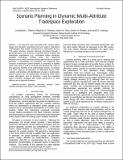| dc.description.abstract | The long time scales associated with complex system
design and operation necessitate front-end systems engineering
methodologies that enable consideration of alternative futures.
This paper advances scenario planning techniques through a
parameterization and ordering of potential future contexts and
stakeholder expectations (e.g., articulated system attributes,
available technology, funding levels, and supporting
infrastructures). After surveying existing approaches for scenario
planning, a methodology for specifying and analyzing large
numbers of alternative system timelines is presented. A satellite
radar case study is used to motivate and illustrate the value of
this approach. Benefits of the methodology include: (1) broader
and more rigorous consideration of alternative future needs,
contexts, and timelines, (2) identification of gaps in traditionally-derived
scenario sets, (3) identification of passively value-robust
system alternatives, and (4) providing a basis for evaluating
system evolution strategies that enable sustainment of value
delivery across potential timelines. | en_US |
